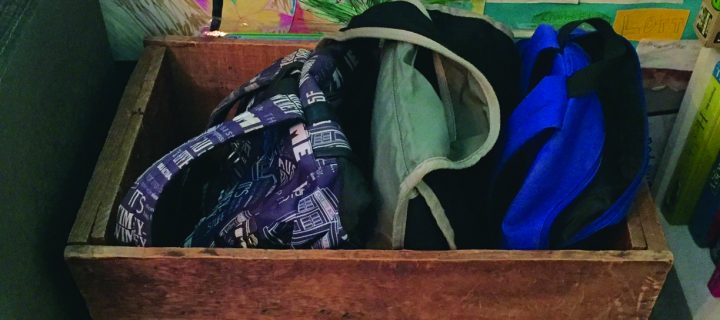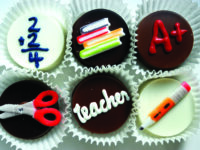Summer flies by and another new school year begins before you have a chance to relax from the previous school year! I remember when my kids were younger and I always felt especially frazzled when a new school year started. Everything seemed to come at us at once: papers to sign, new schedules, new rules, school supplies to get, school clothes to buy, sign-ups for volunteering, sports, etc. As I look back, I realize that, as time went on, I started doing little things to make the next school year start off on a more positive note, and to keep us more organized during the year. Now that I have two middle schoolers and a high schooler, I still keep fine tuning the organization, but I now do more decluttering. In doing so, the school year starts off smoothly.
I have recently realized that life feels calmer when things are more organized and I am slowly recognizing that the act of decluttering helps me to get more organized. If I take the time to get rid of stuff, it clears my mind a bit and I am happier. Believe me when I say, “I have come a long way” with my clutter and disorganization. Do not get me wrong, I still have miles to go, but I will share what I have done that has helped me and my family get more organized.
I have read about the theories of decluttering, but to be honest, I have to forget about the “what gives you joy” method of organizing for the time being. Little of this school stuff gives me a ton of joy and I would toss a lot of it; but I need to be reasonable and try to get what needs to be in the house as organized as I can. It is important to focus on what will make your life run more efficiently. In the long run, you will have more time to focus on the joyful things.
I know you are busy, so I am going to make this as short as possible so you do not have to lock yourself in the bathroom in order to finish a mile long article. I consider myself the queen of lists, so I will share my organizational tips with you in a list (of sorts). Look down the list and see if anything interests you. You can just read about those items that you want to try (guilt free), or you can tear out the list, mark it up, improve upon it; it is your magazine!
Find the space and assign
a purpose.
What spaces are needed to make your days run more smoothly? What is the purpose of the space? I have some shelves in the kids’ playroom that were cluttered with toys, papers, books, and God only knows what else. I decided to assign shelves just for books and in another bookcase, I put baskets for the toys. My kids are older, so I was able to put little toy pieces in clear jars. The jars look cute and organized on the shelves. Having the items in their own place makes clean up easy and it looks nice.
Limit the number of toys and books in the kids’ rooms.
Give away old books and toys to the Salvation Army, Arc, or another family member with children younger than yours. Keep the favorite books and the toys your child, or children, play with regularly. Try to keep these things in one or two rooms. We try to keep most toys in the playroom. If the kids bring toys or games in another room, I have them clean up right when they are done, so we can have the room back and it will not turn into a minefield of stuff.
Set up a bin or basket for extra school supplies.
My kids always need more mechanical pencils, expo markers, felt tip markers, folders, bookmarks, index cards, lined paper and drawing paper throughout the year. We also keep craft supplies in the bin such as glue, colored paper, scissors, and tape for that last minute project. This year, I am putting a ream of computer paper, some flash drives, and an extra ink cartridge into the bin. If some of the stuff does not get used, keep it for next year or donate it at the end of the school year when supplies are scarce in the classroom.
Know important dates before the school year begins. Have a central calendar and if you have a calendar on smart phones or other devices, sync them with family members. Mark the holidays, minimum days, appointments, work schedules, and any information you may have for the school year. The school and district calendars are on the district and school websites. You should also be getting a packet of papers to sign (sarcastic “yay”)that will have important dates listed, as well as transportation pick up/drop off times. As the information comes home, record the dates immediately. Bring your calendar to Back to School Night so you can add dates for volunteering, PTA meetings, field trips, parent conferences, or any other information you may get that night. A dry-erase board or chalkboard may work great for some families that need switch out activities regularly.
Prepare folders, portfolios, or files for your children’s important papers, artwork, and returned work.
After you review work, decide if you really need to keep it. You do not have to announce when you need to make some papers disappear. Keep things that they may need for the year for review or important writings, math milestones, etc. Take pictures of spur of the moment “art” and keep the pieces you would frame or put on a bulletin board. I have a portfolio for each kid and I file special items away into a bin each year if I do not use the art for décor. I actually wallpapered the playroom walls with important artwork and it really is a special room.
Keep a file for “papers to sign and/or return to school.” I used to search frantically all over the dang place for papers that I needed to sign the night before they were due (or the morning they were due). I had piles of papers everywhere! Once I got a simple folder and labeled it “to sign,” I wondered, “What kind of crazy woman would have done it the old way?” This folder can have information from school, permission slips and other important school business papers. One folder can prevent the papers from getting mixed in with bills, receipts, and other non-school mail.
Keep books the kids are currently reading in one place.
Assign an area just for the books your kids are reading for school. I have a book/magazine holder made out of a wood pallet and there are three sections for reading materials. I labeled one for each kid. I ask what they are reading for the night or weekend, and I keep the books in one place. This is great for library books so they will not get lost.
Designate a homework area.
Decide now where the kids can sit down and focus to get homework done. My kids do not like to sit together to do homework. One sits at a desk, and two sit at different places in the kitchen or family room. If desks are where they study, let your children customize their desk area so they look forward to studying and hanging out in their spaces daily. Colorful storage bins, baskets and other organizers can be personalized so the desk is somewhere they want to be.
Make morning and after school as routine as possible.
If kids have a list of what to check off in the morning, you may not have to remind each kid several times about what to do to get out the door. My kids freak out less if they know exactly what they need to do in the morning. We also get lunches, water bottles, backpacks, and clothes out the night before and that makes the mornings easier. After school, I have my kids take out their homework and put it in a certain place (we put it with the reading materials), hang their jackets on hooks, get out their water bottles/lunch boxes from their backpacks, and put the backpacks in a fun antique wooden crate in the playroom. The backpacks got heavier over time, so we could not hang them anymore. After they unload, I have them get a healthy snack and I give them a half hour of free time to do whatever they want before they do three chores and start homework.
Create a calming routine for the evenings.
Evening routines vary, but if you find time to give undivided attention to your kids, they tend to sleep better. I find that when I am too busy to snuggle, talk, play a quiet game, or read a book, my kids ask for that time at bedtime or all night long! Taking those moments out to create a nice routine opens up more time after the kids are asleep.
Do a walk through before the school year begins.
I read some great advice in a blog about doing a run through of the routine and organization you have created. Walk through the different areas of your home and explain how the organization system will work for everyone. Show them what to do when they walk in the door and you will find they feel a part of the team and take pride in the routines. It also keeps parents a little happier when they do not have to keep picking up after, and reminding kids of what to do every second.
Prepare your kids for the unknown.
After my son had several meltdowns when plans had changed, I made sure to explain to my children that the routine may be altered and those times can be exciting. If I know a change in the routine ahead of time, I give the kids ample notice. They need to adjust their brains and get used to the idea of change. Sometimes just saying, “In five minutes we are going to”…helps prevent meltdowns.
Every year before school starts, I look up DIY organizing tips on Pinterest, but they are not always practical for my family. I have tried some things and they have failed miserably. If something works, stick with it and share your knowledge with friends or on social media. When organizing, decide what is most important about your routine, and organize to make your routine help your life be a little easier. It will also free up some time that you can dedicate to family fun!
By DeAnna Holman






